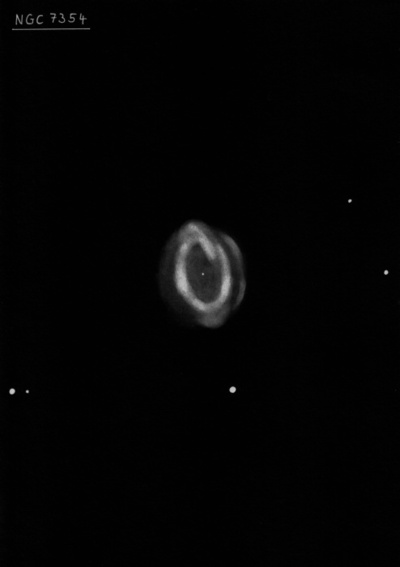
William Herschel discovered NGC 7354 = H II-705 = h2178 on 3 Nov 1787 (sweep 773) and recorded "pB, S, irr R, er, almost of an equal light throughout." JH noted it was "B enough to be noticed and caught in sweeping in full moonlight, with the moon on meridian; pgbM; R; no nucleus seen." NGC 7354 was the most northerly object observed with the Lord Rosse's 72", culminating 8° beyond the zenith.
Based on Crossley photographs taken at Lick, Heber Curtis (1918) reported "a somewhat irregular oval ring, fading out at each end, 22"x18" in p.a. 27°. Outside this is a ring or disk of much fainter matter, rather more circular in form and 32" across from east to west. This outer portion likewise is fainter at the ends of the major axis, and shows brighter streaks at the east and west edges."
200/250mm - 8" faint, small, round, but easily visible at 100x or higher and takes 200x. Very faint star is at the SW edge.
300/350mm - 13.1" (7/12/86): fairly bright, fairly small, slightly elongated. A mag 14 star is just off the SW edge. Pretty with a UHC filter at 166x, estimate V = 12.0. Takes high power without a filter.
400/500mm - 17.5" (11/6/99): a fairly bright, 25" disc is visible at 100x with one or two stars very close. At 280x, the PN is slightly elongated E-W, ~25"x20". A mag 14 star is close off the SW edge, 30" from center and a mag 14.5 star is 0.6' due west. At 380x, a mag 15-15.5 star is 0.6' WNW. In addition, the surface brightness is noticeably irregular with hints of brighter areas.
600/800mm - 24" (8/30/16): at 375x; fairly bright, fairly small, slightly elongated SW-NE, ~25"x20". The rim is brighter along the southeast side and very slightly brighter along the northwest side. The rim dims on the northeast side. A mag 14 star is 0.5' SW, a mag 14-14.5 star is 0.8' W and a mag 15 star is 0.7' NW. At 500x, the planetary clearly has a mottled appearance with what appears to be several very small brighter spots that wink in and out.
Notes by Steve Gottlieb